ECU MAZDA MODEL 3 4-DOOR 2018 Owners Manual
[x] Cancel search | Manufacturer: MAZDA, Model Year: 2018, Model line: MODEL 3 4-DOOR, Model: MAZDA MODEL 3 4-DOOR 2018Pages: 624, PDF Size: 59.23 MB
Page 16 of 624
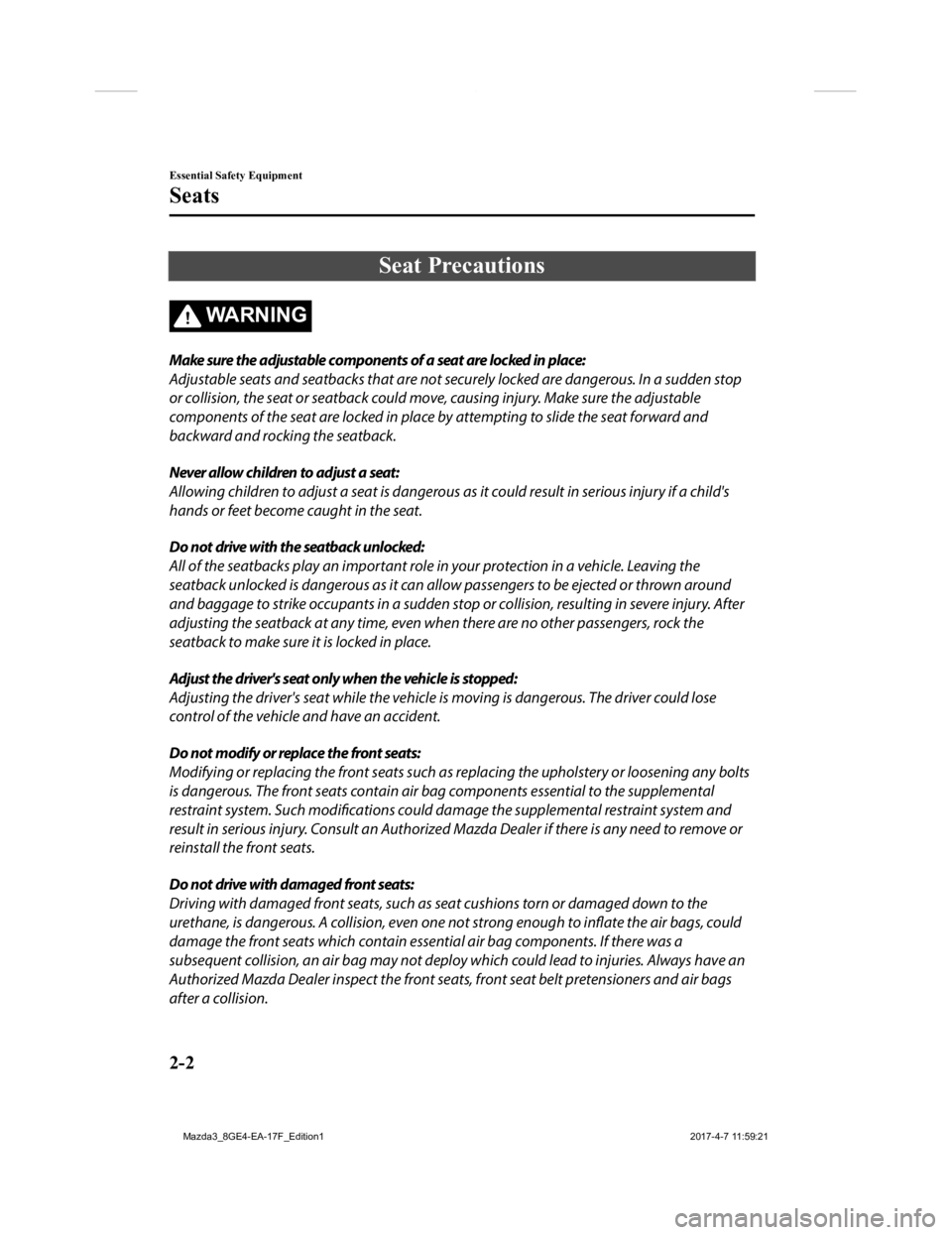
Seat Precautions
WA R N I N G
Make sure the adjustable components of a seat are locked in place:
Adjustable seats and seatbacks that are not securely locked are dangerous. In a sudden stop
or collision, the seat or seatback could move, causing injury. Make sure the adjustable
components of the seat are locked in place by attempting to slide the seat forward and
backward and rocking the seatback.
Never allow children to adjust a seat:
Allowing children to adjust a seat is dangerous as it could result in serious injury if a child's
hands or feet become caught in the seat.
Do not drive with the seatback unlocked:
All of the seatbacks play an important role in your protection in a vehicle. Leaving the
seatback unlocked is dangerous as it can a llow passengers to be ejected or thrown around
and baggage to strike occupants in a sudden stop or collision, resulting in severe injury. After
adjusting the seatback at any time, even when there are no other passengers, rock the
seatback to make sure it is locked in place.
Adjust the driver's seat only when the vehicle is stopped:
Adjusting the driver's seat while the vehicle is moving is dangerous. The driver could lose
control of the vehicle and have an accident.
Do not modify or replace the front seats:
Modifying or replacing the front seats such as replacing the upholstery or loosening any bolts
is dangerous. The front seats contain air ba g components essential to the supplemental
restraint system. Such modifications could damage the supplemental restraint system and
result in serious injury. Consul t an Authorized Mazda Dealer if there is any need to remove or
reinstall the front seats.
Do not drive with damaged front seats:
Driving with damaged front seats, such as seat cushions torn or damaged down to the
urethane, is dangerous. A collision, even one not strong enough to inflate the air bags, could
damage the front seats which contain essential air bag components. If there was a
subsequent collision, an air bag may not deploy which could lead to injuries. Always have an
Authorized Mazda Dealer inspect the front seats, front seat belt pretensioners and air bags
after a collision.
Essential Safety Equipment
Seats
2-2
Mazda3_8GE4-EA-17F_Edition1 2017-4-7 11:59:21
Page 17 of 624

Do not drive with either front seats reclined:
Sitting in a reclined position while the vehicle is moving is dangerous because you do not get
the full protection from seat be lts. During sudden braking or a collision, you can slide under
the lap belt and suffer serious internal injuri es. For maximum protection, sit well back and
upright.
Do not place an object such as a cushion between the seatback and your back:
Putting an object such as a cushion betwee n the seatback and your back is dangerous
because you will be unable to maintain a safe driving posture and the seat belt cannot
function at its full capacity in a collision, wh ich could result in a serious accident, injury or
death.
Do not place objects under the seat:
The object could get stuck and cause the seat to not be fixed securely, and result in an
accident.
Do not stack cargo higher than the seatbacks:
Stacking luggage or other cargo higher than the seatbacks is dangerous. During sudden
braking or a collision, objects can fly around and become projectiles that may hit and injure
passengers.
Make sure luggage and cargo is secured before driving:
Not securing cargo while driving is dangerous as it could move or be crushed during sudden
braking or a collision and cause injury.
Never allow a passenger to sit or stand on the folded seatback while the vehicle is moving:
Driving with a passenger on the folded seatback is dangerous. Allowing a child to sit up on
the folded seatback while the vehicle is moving is particularly dangerous. In a sudden stop or
even a minor collision, a child not in a proper seat or child-restraint system and seat belt could
be thrown forward, back or even out of the vehi cle resulting in serious injuries or death. The
child in the baggage area could be thrown into other occupants and cause serious injury.
Never give the car keys to children and do not allow them to play in the vehicle (4–Door):
Playing with the folding rear seats is dangerous. Once the seatbacks are back up, a child in the
trunk would not be able to get out the way they had entered. If you have small children, keep
the seatbacks locked.
Essential Safety Equipment
Seats
2-3
Mazda3_8GE4-EA-17F_Edition1 2017-4-7 11:59:21
Page 21 of 624
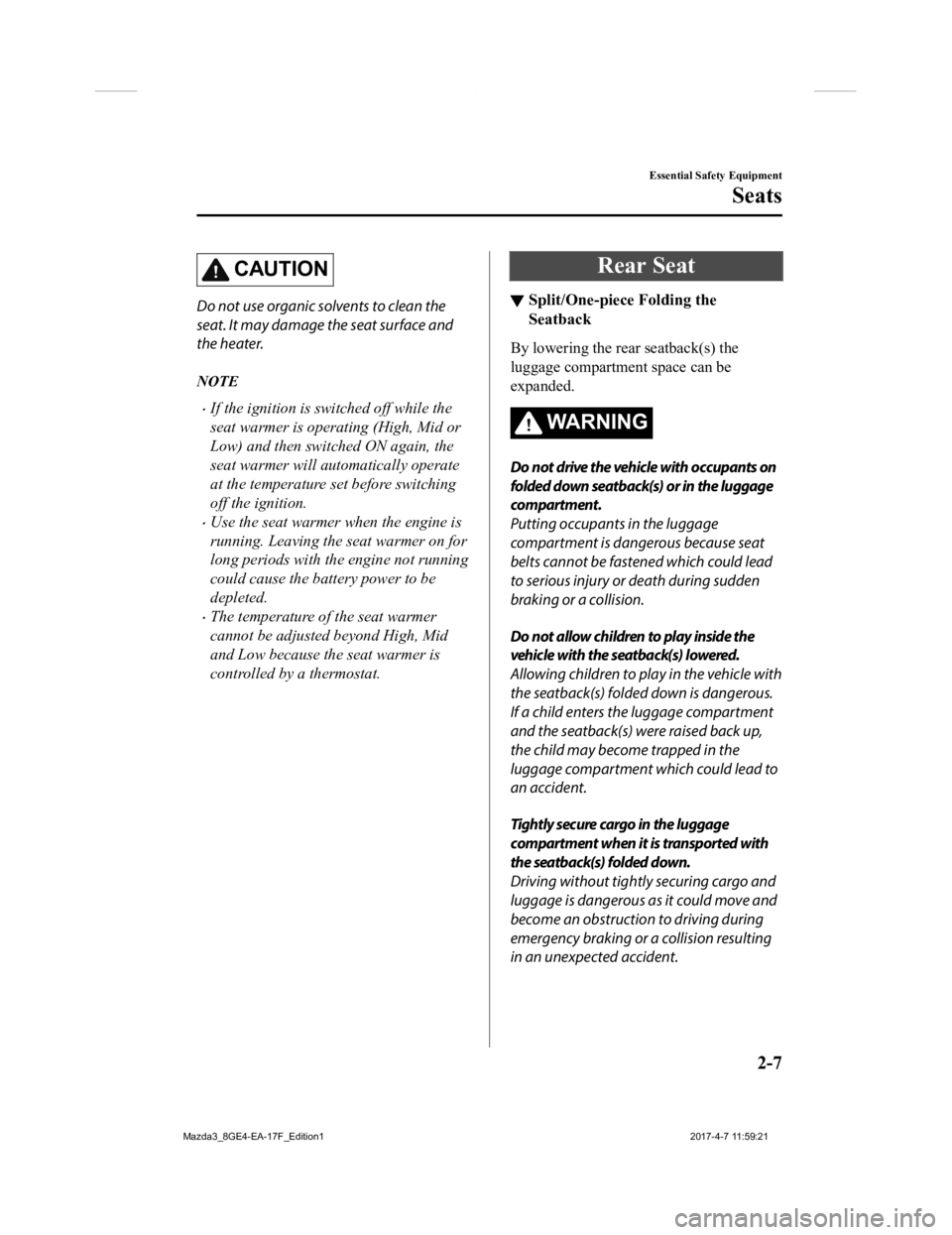
CAUTION
Do not use organic solvents to clean the
seat. It may damage the seat surface and
the heater.
NOTE
If the ignition is switched off while the
seat warmer is operating (High, Mid or
Low) and then switched ON again, the
seat warmer will automatically operate
at the temperature set before switching
off the ignition.
Use the seat warmer when the engine is
running. Leaving the seat warmer on for
long periods with the engine not running
could cause the battery power to be
depleted.
The temperature of the seat warmer
cannot be adjusted beyond High, Mid
and Low because the seat warmer is
controlled by a thermostat.
Rear Seat
▼Split/One-piece Folding the
Seatback
By lowering the rear seatback(s) the
luggage compartment space can be
expanded.
WA R N I N G
Do not drive the vehicle with occupants on
folded down seatback(s) or in the luggage
compartment.
Putting occupants in the luggage
compartment is dangerous because seat
belts cannot be fastened which could lead
to serious injury or death during sudden
braking or a collision.
Do not allow children to play inside the
vehicle with the seatback(s) lowered.
Allowing children to play in the vehicle with
the seatback(s) folded down is dangerous.
If a child enters the luggage compartment
and the seatback(s) were raised back up,
the child may become trapped in the
luggage compartment which could lead to
an accident.
Tightly secure cargo in the luggage
compartment when it is transported with
the seatback(s) folded down.
Driving without tightly securing cargo and
luggage is dangerous as it could move and
become an obstruction to driving during
emergency braking or a collision resulting
in an unexpected accident.
Essential Safety Equipment
Seats
2-7
Mazda3_8GE4-EA-17F_Edition1
2017-4-7 11:59:21
Page 23 of 624
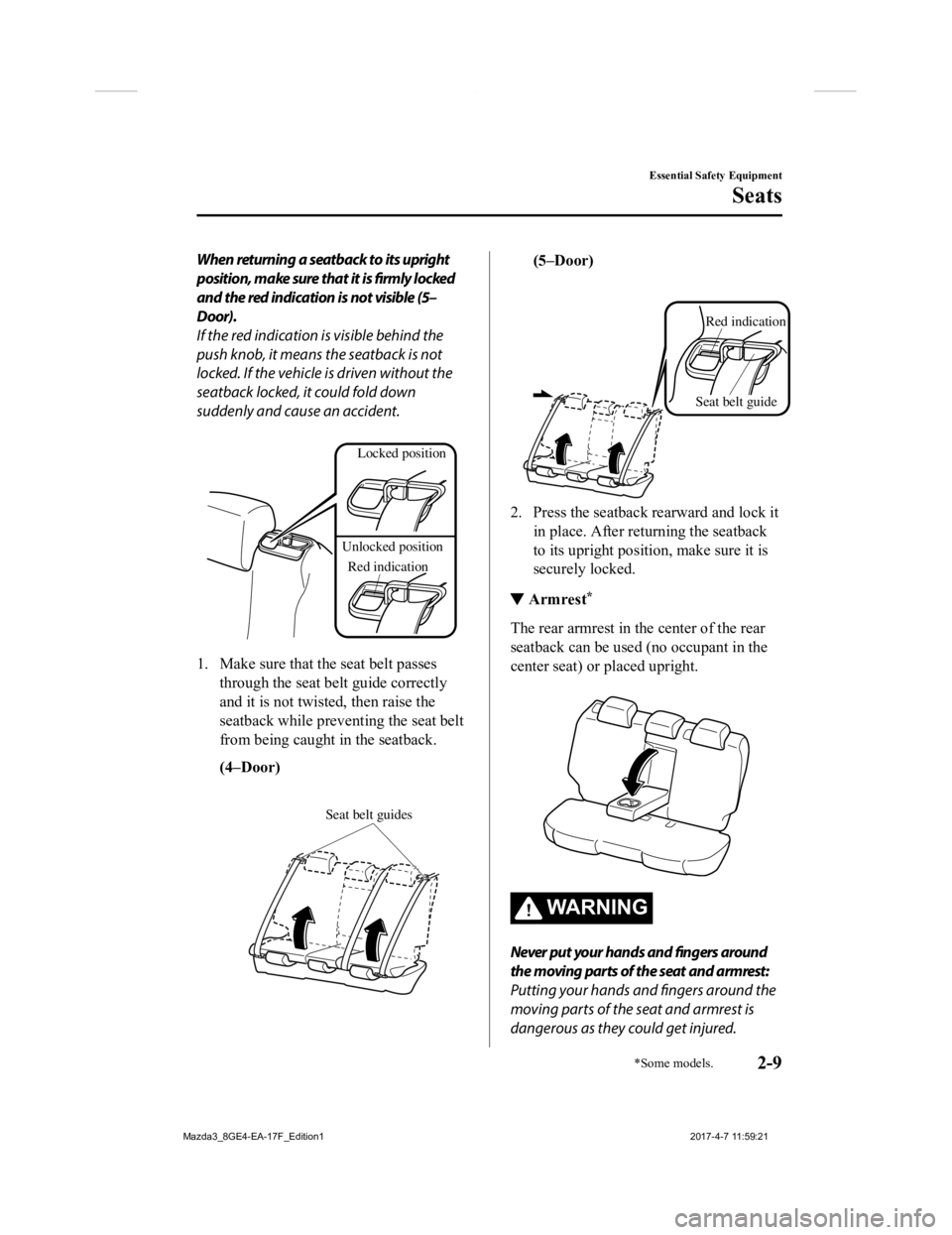
When returning a seatback to its upright
position, make sure that it is firmly locked
and the red indication is not visible (5–
Door).
If the red indication is visible behind the
push knob, it means the seatback is not
locked. If the vehicle is driven without the
seatback locked, it could fold down
suddenly and cause an accident.
Locked position
Unlocked position Red indication
1. Make sure that the seat belt passes through the seat belt guide correctly
and it is not twisted, then raise the
seatback while preventing the seat belt
from being caught in the seatback.
(4–Door)
Seat belt guides
(5–Door)
Red indication
Seat belt guide
2. Press the seatback rearward and lock it in place. After returning the seatback
to its upright posit ion, make sure it is
securely locked.
▼ Armrest*
The rear armrest in the center of the rear
seatback can be used (no occupant in the
center seat) or placed upright.
WA R N I N G
Never put your hands and fingers around
the moving parts of the seat and armrest:
Putting your hands and fingers around the
moving parts of the seat and armrest is
dangerous as they
could get injured.
Essential Safety Equipment
Seats
*Some models.2-9
Mazda3_8GE4-EA-17F_Edition1 2017-4-7 11:59:21
Page 26 of 624
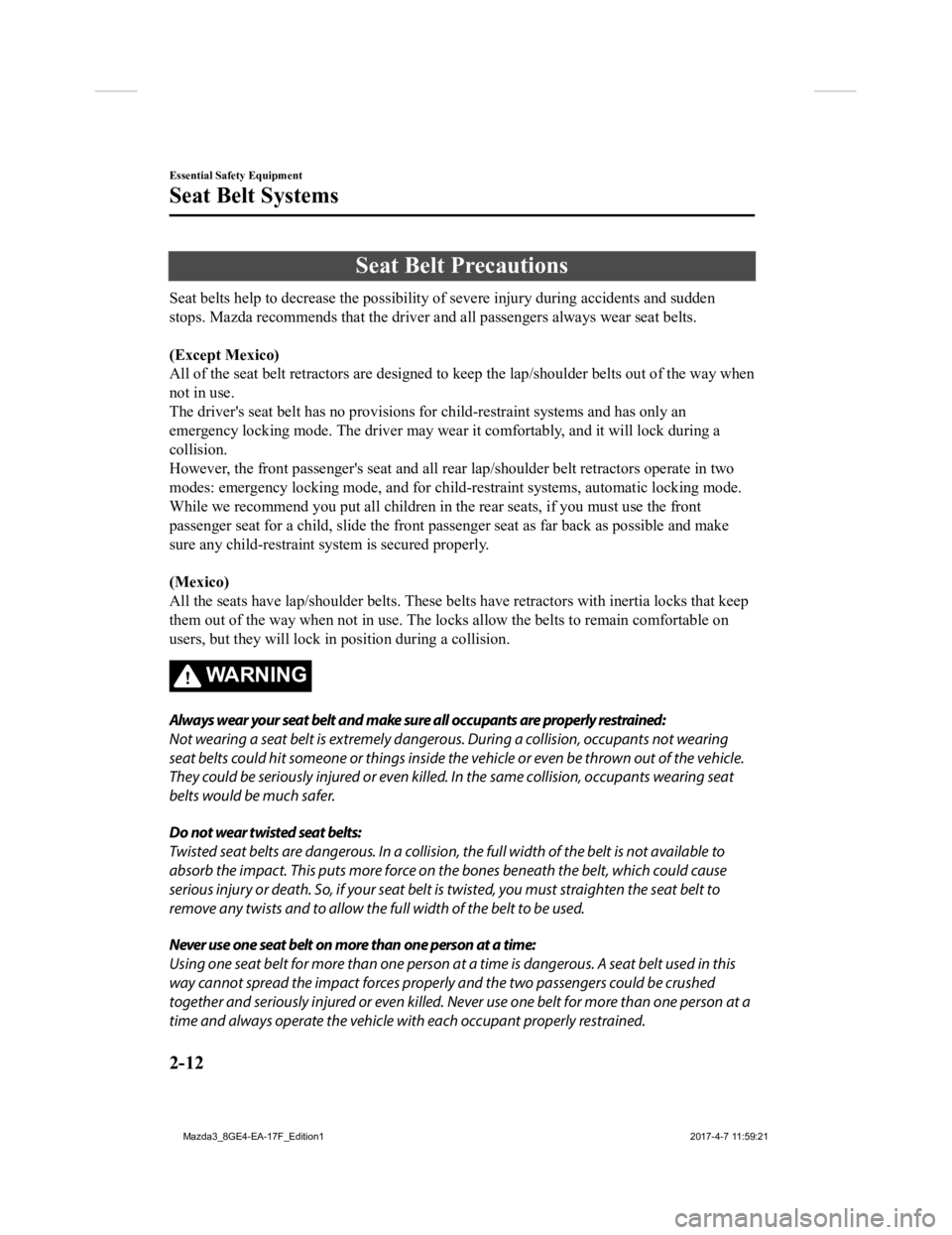
Seat Belt Precautions
Seat belts help to decrease the possibility of severe injury during accidents and sudden
stops. Mazda recommends that the driver and all passengers always wear seat belts.
(Except Mexico)
All of the seat belt retractors are designed to keep the lap/sh oulder belts out of the way when
not in use.
The driver's seat belt has no provisions for child-restraint sy stems and has only an
emergency locking mode. The driver may wear it comfortably, and it will lock during a
collision.
However, the front passenger's seat and all rear lap/shoulder b elt retractors operate in two
modes: emergency locking mode, and for child-restraint systems, automatic locking mode.
While we recommend you put all chi ldren in the rear seats, if you must use the front
passenger seat for a child, slide the front passenger seat as f ar back as possible and make
sure any child-restraint sy stem is secured properly.
(Mexico)
All the seats have lap/shoulder belts. These belts have retract ors with inertia locks that keep
them out of the way when not in use. The locks allow the belts to remain comfortable on
users, but they will lock in position during a collision.
WA R N I N G
Always wear your seat belt and make sure all occupants are properly restrained:
Not wearing a seat belt is extremely dangerou s. During a collision, occupants not wearing
seat belts could hit someone or things inside th e vehicle or even be thrown out of the vehicle.
They could be seriously injured or even killed . In the same collision, occupants wearing seat
belts would be much safer.
Do not wear twisted seat belts:
Twisted seat belts are dangerous. In a collision, the full width of the belt is not available to
absorb the impact. This puts more force on the bones beneath the belt, which could cause
serious injury or death. So, if your seat belt is twisted, you must straighten the seat belt to
remove any twists and to allow the full width of the belt to be used.
Never use one seat belt on more than one person at a time:
Using one seat belt for more than one person at a time is dangerous. A seat belt used in this
way cannot spread the impact forces properly and the two passengers could be crushed
together and seriously injured or even killed. Never use one belt for more than one person at a
time and always operate the vehicle with each occupant properly restrained.
Essential Safety Equipment
Seat Belt Systems
2-12
Mazda3_8GE4-EA-17F_Edition1 2017-4-7 11:59:21
Page 34 of 624

Child-Restraint Precautions
Mazda strongly urges the use of child-restraint systems for children small enough to use
them.
You are required by law to use a child-restraint system for children in the U.S. and Canada.
Check your local and state or provincial laws for specific requ irements regarding the safety
of children riding in your vehicle.
Whatever child-restraint system you consider, please pick the a ppropriate one for the age
and size of the child, obey the law and follow the instructions that come with the individual
child-restraint system.
A child who has outgrown child-r estraint systems should sit in the rear and use seat belts,
both lap and shoulder. If the shoulder belt crosses the neck or face, move the child closer to
the center of the vehicle in the outboard seats, and towards the buckle on the right if the
child is seated on the center seat.
Statistics confirm that the rear seat is the best place for all children up to 12 years of age,
and more so with a supplemental restraint system (air bags).
A rear-facing child-restraint system should NEVER be used on the front seat with the air
bag system activated. The front passenger's seat is also the le ast preferred seat for other
child-restraint systems.
(With Front Passenger Occupa nt Classification System)
To reduce the chance of injuries caused by deployment of the fr ont passenger air bag, the
front passenger occupant classification sensor works as a part of the supplemental restraint
system. This system deactivates the front passenger front and side air bags and also the front
passenger seat belt pretensioner system when the front passenge r air bag deactivation
indicator light illuminates.
When an infant or small child sits on the front passenger seat, the system shuts off the front
passenger front and side air bags and seat belt pretensioner sy stem, so make sure the front
passenger air bag deactivation indicator light illuminates.
Even if the front passenger air bag is shut off, Mazda strongly recommends that children be
properly restrained and child-rest raint systems of all kinds are properly secured on the rear
seats which are the best place for children.
For more details, refer to "Front passenger occupant classification sensor" (page 2-61).
Essential Safety Equipment
Child-Restraint
2-20
Mazda3_8GE4-EA-17F_Edition1 2017-4-7 11:59:21
Page 35 of 624

WA R N I N G
Use the correct size child-restraint system:
For effective protection in vehicle accidents and sudden stops, a child must be properly
restrained using a seat belt or child-restraint system depending on age and size. If not, the
child could be seriously injured or even killed in an accident.
Follow the manufacturer's instructions and always keep the child-restraint system buckled
down:
An unsecured child-restraint system is dangerous. In a sudden stop or a collision it could move
causing serious injury or death to the child or other occupants. Make sure any child-restraint
system is properly secured in place accordin g to the child-restraint system manufacturer's
instructions. When not in use, remove it from the vehicle or fasten it with a seat belt, or latch it
down to BOTH LATCH lower anchors for LATCH child-restraint systems and the corresponding
tether anchor.
Always secure a child in a proper child-restraint system:
Holding a child in your arms while the vehicle is moving is extremely dangerous. No matter
how strong the person may be, he or she cannot ho ld onto a child in a sudden stop or collision
and it could result in serious injury or death to the child or other occupants. Even in a
moderate accident, the child may be exposed to air bag forces that could result in serious
injury or death to the child, or the child may be slammed into an adult, causing injury to both
child and adult.
Never use a rear-facing child-restraint system in the front seat with an air bag that could
deploy:
Rear-facing child-restraint systems on the fron t seat are particularly dangerous even though
you may feel assured that a front passenger air bag will not deploy based on the fact that the
front passenger air bag deactivation indicator light illuminates. The child-restraint system can
be hit by a deploying air bag and moved violently backward resulting in serious injury or
death to the child.
Essential Safety Equipment
Child-Restraint
2-21
Mazda3_8GE4-EA-17F_Edition1 2017-4-7 11:59:21
Page 38 of 624

Never use one seat belt on more than one person at a time:
Using one seat belt for more than one person at a time is dangerous. A seat belt used in this
way cannot spread the impact forces properly and the two passengers could be crushed
together and seriously injured or even killed. Never use one belt for more than one person at a
time and always operate the vehicle with each occupant properly restrained.
CAUTION
A seat belt or child-restraint system can become very hot in a closed vehicle during warm
weather. To avoid burning yourself or a child, check them before you or your child touches
them.
NOTE
Your Mazda is equipped with LATCH lower an chors for attachment of specially designed
LATCH child-restraint systems in the rear seats. When using these anchors to secure a
child-restraint system, refer to "U sing LATCH Lower Anchor" (page 2-40).
Essential Safety Equipment
Child-Restraint
2-24
Mazda3_8GE4-EA-17F_Edition1 2017-4-7 11:59:21
Page 41 of 624
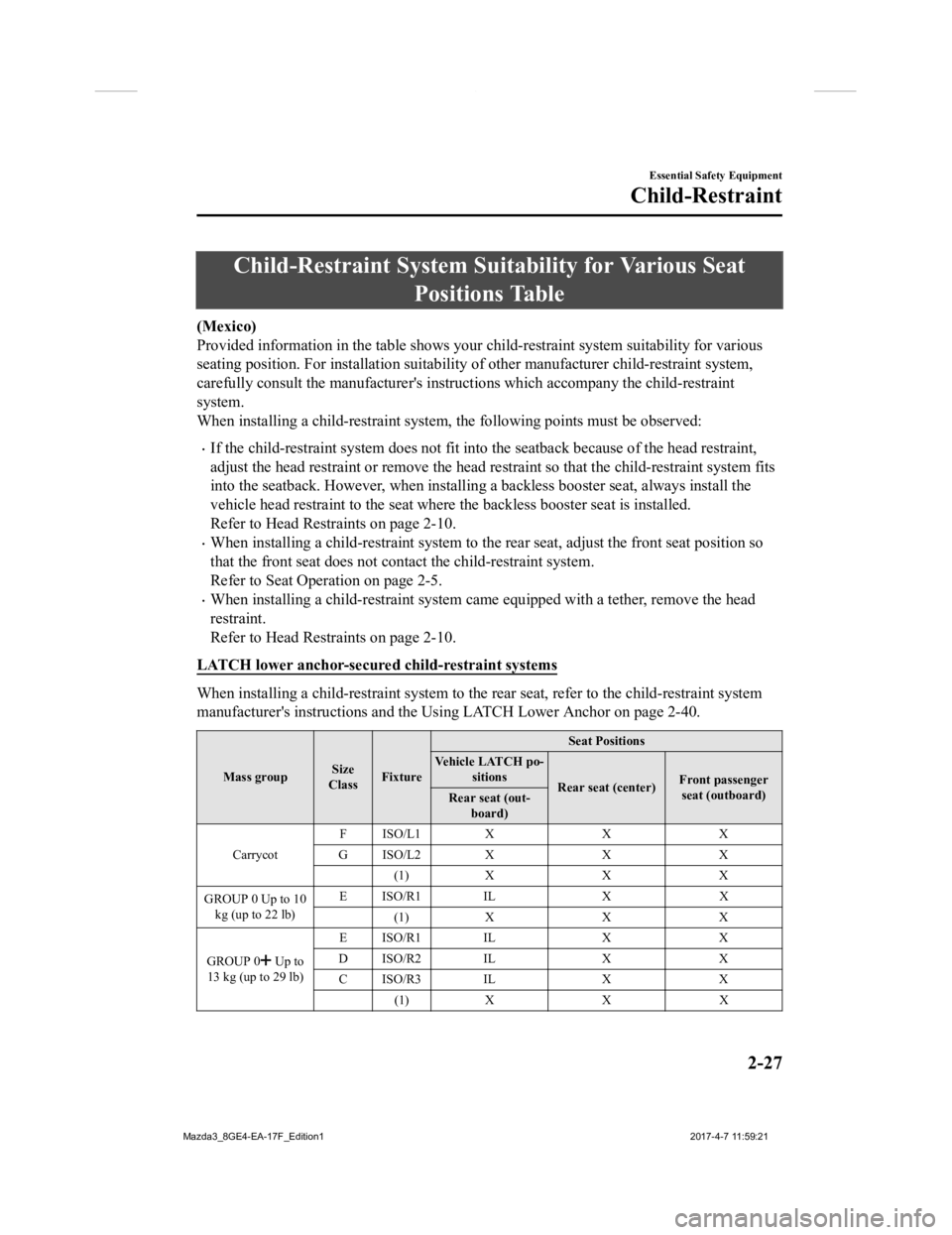
Child-Restraint System Suitability for Various Seat
Positions Table
(Mexico)
Provided information in the tabl e shows your child-restraint system suitability for various
seating position. For installation suitability of other manufac turer child-restraint system,
carefully consult the manufacture r's instructions which accompany the child-restraint
system.
When installing a child-restraint system, the following points must be observed:
If the child-restraint system does not fit into the seatback because of the head restraint,
adjust the head restraint or remove the head restraint so that the child-restraint system fits
into the seatback. However, when installing a backless booster seat, always install the
vehicle head restraint to the seat where the backless booster s eat is installed.
Refer to Head Restraints on page 2-10.
When installing a child-restrain t system to the rear seat, adjust the front seat position so
that the front seat does not contact the child-restraint system .
Refer to Seat Operation on page 2-5.
When installing a child-restraint system came equipped with a t ether, remove the head
restraint.
Refer to Head Restraints on page 2-10.
LATCH lower anchor-secured child-restraint systems
When installing a child-restraint system to the rear seat, refer to the child-restraint system
manufacturer's instructions and the Using LATCH Lower Anchor on page 2-40.
Mass groupSize
Class Fixture Seat Positions
Vehicle LATCH po- sitions Rear seat (center) Front passenger
seat (outboard)
Rear seat (out-
board)
Carrycot FISO/L1 X
XX
GISO/L2 X XX
(1) X X X
GROUP 0 Up to 10 kg (up to 22 lb) EISO/R1 IL
XX
(1) X X X
GROUP 0
Up to
13 kg (up to 29 lb) EISO/R1 IL X X
DISO/R2 IL XX
CISO/R3 IL XX
(1) X X X
Essential Safety Equipment
Child-Restraint
2-27
Mazda3_8GE4-EA-17F_Edition1 2017-4-7 11:59:21
Page 43 of 624
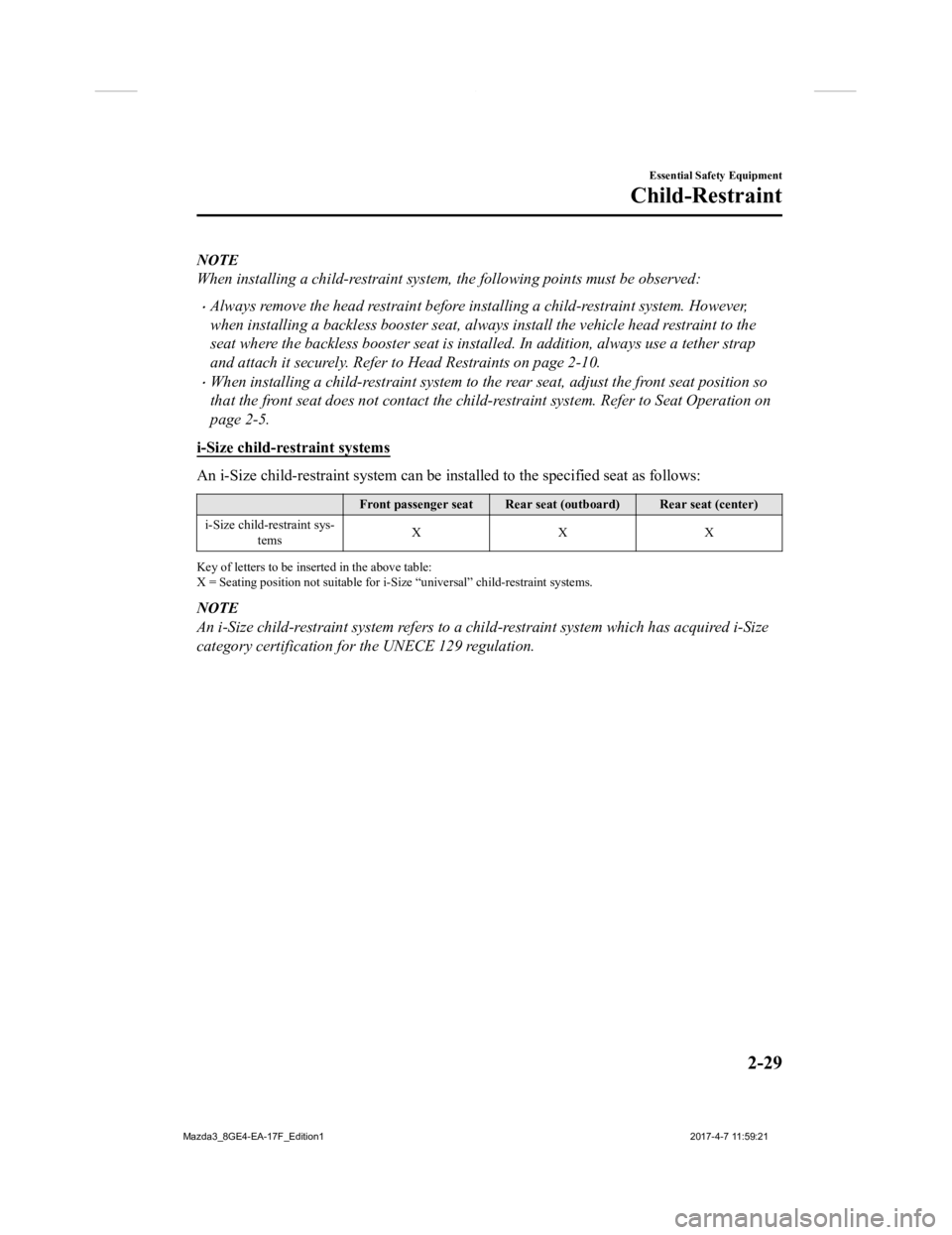
NOTE
When installing a child-restraint system, the follo wing points must be observed:
Always remove the head restraint before in stalling a child-restraint system. However,
when installing a backless booster seat, always install the vehicle head restraint to the
seat where the backless booster seat is installed. In addition, always use a tether strap
and attach it securely. Refer to Head Restraints on page 2-10.
When installing a child-restraint system to the rear seat, adjust the front seat position so
that the front seat does not contact the child- restraint system. Refer to Seat Operation on
page 2-5.
i-Size child-restraint systems
An i-Size child-restra int system can be installed to the specif ied seat as follows:
Front passenger seat Rear seat (outboard) Rear seat (center)
i-Size child-restraint sys- tems XXX
Key of letters to be inserted in the above table:
X = Seating position not suitable for i-Size “universal” child-
restraint systems.
NOTE
An i-Size child-restraint system refers to a child-restraint system which has acquired i-Size
category certification for the UNECE 129 regulation.
Essential Safety Equipment
Child-Restraint
2-29
Mazda3_8GE4-EA-17F_Edition1 2017-4-7 11:59:21